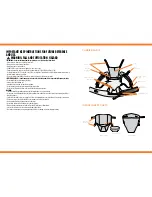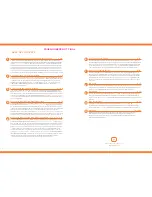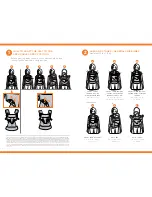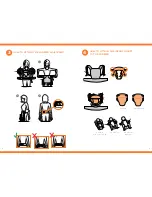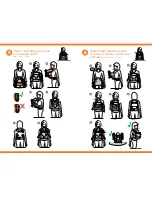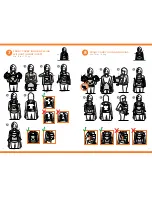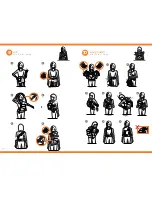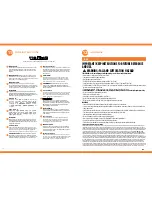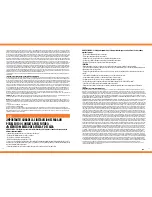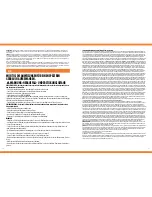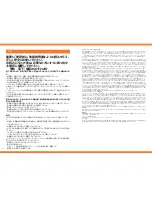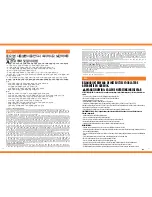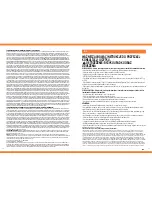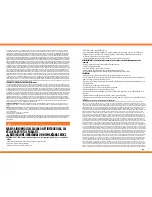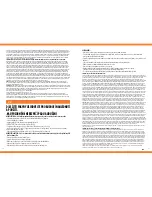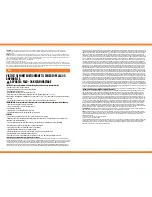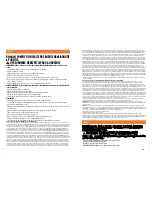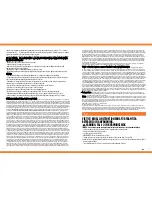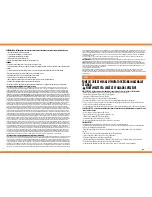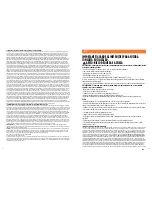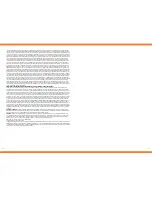
18
19
ES
digestion and absorption, it is recommended not to use a carrier for about 30 minutes after nursing or bottle feeding. The carrier must be worn in such a way that
a baby can move his head without pressing his face onto your body. When using the hood, please ensure that the hood is NOT completely covering baby’s face and
check on your baby regularly. Be sure that there is enough opening for air to pass through. Ensure that baby’s fingers are not caught in a buckle opening or gap as
this may cause injury to the baby. Always fasten the buckles properly when the carrier is not in use. Keep the carrier away from children when it is not in use. Check
to assure all buckles, snaps, straps and adjustments are secure before each use. Regularly inspect the carrier and the infant insert for any sign of wear and damage.
Never use a carrier or infant insert when damaged in anyway. Check for ripped seams, torn straps or fabrics and damaged fasteners before each use. Regularly
check straps and buckles while in use to make sure they have proper tension and placement. Only use the front outward-facing, back and hip carry positions when
baby has demonstrated strong and consistent head and neck control. Do not switch between positions with your baby in the Carrier. Take the baby out of the Carrier
before changing the position of the Carrier. To avoid injury when learning to place the baby in the Carrier, do so over a bed or other cushioned surface with the
assistance of another adult. Whenever possible, wear and remove the carrier close to a safe receiving surface for baby and in a safe place. Take particular care when
a baby is carried in a back carry position. For smaller babies or for adults with long torso, wear the carrier waist belt higher on body so baby’s head is positioned
close enough to kiss when using the front carry position. The Carrier and Infant Insert should not be used unless and until the wearer understands the instructions
and safety features, and is confident and comfortable with respect to the use of the Carrier and Infant Insert. This Carrier is only intended for use by healthy adults.
As a general rule, an individual in good health should be able to carry 20% of their body weight in a traditional backpack design. The Carrier should not be used
by a person with any health problems that might interfere with the safe use of the product. If the person using the Carrier should develop shoulder, back, or neck
problems, discontinue its use and consult a qualified medical professional. Discontinue use of the Carrier and/or Infant Insert if the baby shows signs of discomfort
while being carried for a period of time until the baby can be carried without exhibiting discomfort.
Contact Ergobaby customer service representative for additional assistance if needed. For instructional video and additional tips, please visit www.ergobaby.com
(English only).
PRECAUTIONS FOR USE AND INSTRUCTIONS SPECIFIC FOR ERGOBABY™ INFANT INSERT:
The leg position of the infant in the Infant Insert will change as your infant grows. The infant insert will support your newborn’s thighs in a spread squat position,
knees level with the belly button and legs resting on the sides of the infant insert inside the carrier. As your infant grows, the knees will lower but still higher than
the hips, and the legs will rest outside of the infant insert and the carrier. Ensure proper placement of infant in product including leg placement. The infant’s posi-
tion should be checked regularly to make sure that the infant is properly seated in the Infant Insert, centered with legs in a spread-squat position and head upright
and not slumping downward or to the side. Use the inner snap setting on the top of the insert insert (padded head and neck support) for a tighter fit and more
support for your newborn. As baby grows and starts to hold head for a few moments, and turn it from side to side, you can start using the outer snap setting. This
is usually around 6 weeks. Once baby is more than 12 lbs (5.5 kg) AND has strong and consistent head and neck control, one can discontinue use of the Infant Insert.
This is usually around 4 months. Ensure that the infant’s airway is clear and that the infant is breathing normally at ALL TIMES. Infant’s chin should NEVER rest on
infant’s chest because this partially closes infants’s airway. There should be at least two fingers width clearance below infants’s chin. Infant’s arms, legs and feet
need to be observed regularly while in the Carrier to ensure that they are not constricted by the Carrier. Premature infants, infants with respiratory problems, and
infants under 4 months are at greatest risk of suffocation. The Infant Insert is not to be used in lying or reclined position and outside of the carrier.
The references to ages by month are only general guidelines and each baby’s development is different. Please check that your baby meets the specific requirements
for use. In addition, Carrier is not to be used with babies less than 7lbs (3.2 kg).
Disclaimer:
Ergobaby™ uses only the highest quality and safest dyes possible to ensure a product that will retain its color, but is free from harmful chemicals. There
is always a possibility that colors will fade with washing. Ergobaby cannot be held responsible for faded colors due to laundering.
Warranty:
Please see Ergobaby.com for information about our warranty. The ERGO Baby Carrier, Inc. warrants its products against defects in materials and work-
manship. We stand behind all our products and will either repair or replace, free of charge during the first 12 months after purchase, any Ergobaby™ product that is
defective. Proof of purchase is necessary and product must be returned for warranty service. Should you have a warranty claim, please contact Ergobaby Customer
Service at:
US: [email protected], or 888-416-4888
EU: [email protected] or 0049 40 421 065 0
Warranty Coverage does not extend to damage caused by misuse or any use of the Carrier that is not in accordance with the instructions stated in this manual.
Warranty coverage does not extend to any Carrier that has been modified from its original construction in any way. Different or additional warranty rights may exist
in the purchaser’s jurisdiction. To the extent that different or additional warranty rights exist under the laws of the purchaser’s jurisdiction, those warranties shall
apply and be in addition to the warranty rights.
¡IMPORTANTE! GUARDE LAS INSTRUCCIONES PARA UN
POSIBLE USO O CONSULTA EN EL FUTURO.
ATENCIÓN: RIESGO DE ASFIXIA Y DE CAÍDA
RIESGO DE CAÍDA – El bebé podría caerse de la Mochila Portabebé y/o del Cojín Bebé, o también si la apertura para las
piernas es demasiado grande.
• Compruebe la seguridad de todos los cierres antes de cada uso.
• Tenga especial cuidado cuando se incline o al andar.
• No se doble por la cintura: doble las rodillas.
• NO USAR con bebés que pesen menos de 3,2 kg.
• Salvo en el caso indicado a continuación, utilice este Mochila Portabebé únicamente para transportar bebés de entre 5,5 y
15 kg de peso. Los bebés que pesen entre 3,2 kg y 5,5 kg deben ir en el Cojín Bebé Ergobaby™, y se deben llevar únicamente en
la posición frontal mirando hacia dentro.
• Para evitar cualquier riesgo de caída, asegúrese de que el niño está bien colocado en la mochila.
➥
RIESGO DE ASFIXIA – Los bebés que tengan menos de 4 meses podrían ahogarse con este producto si la cara está muy
pegada a su cuerpo.
• No ate el bebé demasiado pegado a su cuerpo.
• Deje espacio para que pueda mover la cabeza.
• Asegúrese de que la cara del bebé no esté obstruida en ningún momento.
• No deje que el bebé se duerma en la posición frontal mirando hacia fuera.
• No utilice el Cojín Bebé en la posición frontal mirando hacia fuera.
tATENCIÓN:
• Mantenga vigilado a su hijo en todo momento y asegúrese de que no tiene la boca ni la nariz obstruidas.
• En el caso de bebés prematuros, bebés con poco peso o niños con problemas médicos, se debe consultar a un profesional
sanitario antes de usar este producto.
• Asegúrese de que la barbilla de su hijo no choca con el pecho, ya que esto podría afectar a su respiración y hacer que se
ahogue.
• Podría perder el equilibrio por su propio movimiento o por el movimiento del niño.
• Tenga cuidado cuando se doble o se incline hacia delante o hacia los lados.
• No permita que el bebé inserte los dedos en cualquier abertura de la hebilla.
• No deje nunca a un bebé sin vigilancia dentro de la Mochila Portabebé y/o del Cojín Bebé Ergobaby™.
• Solo utilice el Cojín Bebé en la posición frontal mirando hacia dentro.
• Esta mochila no debería usarse mientras se realicen actividades deportivas como correr, montar en bicicleta, nadar o
esquiar.
PRECAUCIONES DE USO DE LA MOCHILA ERGOBABYTM 360:
Lea todas las instrucciones antes de montar y usar el Portabebé y el Cojín Bebé. Utilice este Mochila Portabebé únicamente para transportar bebés de entre 5,5 y
15 kg de peso. Los bebés que pesen entre 3,2 kg y 5,5 kg deben ir en el Cojín Bebé Ergobaby™, y se deben llevar únicamente en la posición frontal mirando hacia
dentro. Los bebés que pesen más de 5,5 kg pero que tengan menos de 4 meses o que no tengan un control fuerte y consistente del cuello y la cabeza deberán se-
guir utilizando el Cojín Bebé Ergobaby™ junto con la Mochila Portabebé. El Cojín Bebé Ergobaby™ ha sido diseñada para apoyar la cabeza y el cuello y garantizar que
el recién nacido esté correctamente sentado en el interior de la Mochila Portabebé Ergobaby™. Todos los Cojines Bebé Ergobaby™ se pueden utilizar con cualquier
Mochila Portabebé Ergobaby™. El Cojín Bebé SOLO debe utilizarse para llevar al bebé EN LA POSICIÓN FRONTAL MIRANDO HACIA DENTRO. Practique cómo colocarse la
Mochila Portabebé antes de utilizarla en combinación con el Cojín Bebé.
EL BEBÉ DEBE ESTAR DE CARA AL ADULTO HASTA QUE PUEDA MANTENER LA CABEZA ERGUIDA POR SÍ MISMO. No deje nunca a un bebé sin vigilancia dentro de la Mochila
Portabebé y/o del Cojín Bebé Ergobaby™. Jamás utilice este producto si tiene problemas de equilibrio o movilidad debidos al ejercicio físico, por somnolencia o a
causa de algún problema de salud. Nunca utilice este producto mientras realice actividades como cocinar o limpiar, en las que deba manipular una fuente de calor o
que supongan la exposición a productos químicos. No lleve nunca puesto un Portabebé de estas características mientras conduzca o cuando vaya como pasajero en
un vehículo. Si toma bebidas calientes mientras utiliza la mochila, tenga cuidado de no derramar el líquido sobre el bebé. Nunca desabroche la hebilla del cinturón
mientras el bebé está dentro. Tenga en cuenta que, a medida que el bebé se vuelva más activo, tendrá más riesgo de caerse de la mochila. Lleve únicamente a un
niño en la mochila portabebés.
La barbilla del bebé NUNCA debería descansar contra su propio pecho porque eso puede cerrarle parcialmente la vía respiratoria.
Siempre debe haber por lo menos dos dedos de espacio libre delante de la barbilla del bebé. Asegúrese que las vías respiratorias del bebé estén despejadas y que
el bebé esté respirando normalmente TODO EL TIEMPO. El riesgo de ahogamientos es mayor en los bebés prematuros, los bebés con problemas respiratorios y los
bebés de menos de 4 meses de edad. Asegúrese de colocar correctamente el bebé en el producto, sin olvidar la posición de las piernas. Es necesario comprobar la
posición del bebé con regularidad para asegurarse de que esté correctamente sentado en la Mochila, centrado, con las piernas separadas y flexionadas, y la cabeza
erguida, y que no esté demasiado hundido ni inclinado hacia un lado. Las piernas y los pies del bebé deben observarse con frecuencia mientras el bebé esté dentro
de la Mochila Portabebé para asegurarse de que no coarte el movimiento de las extremidades. Para eliminar la posible compresión del abdomen y ayudar a una
correcta digestión y absorción de los alimentos, se recomienda no llevar al bebé en la mochila en los 30 minutos posteriores a una toma. La mochila se debe llevar
de tal forma que el bebé pueda mover la cabeza sin que esta presione contra su cuerpo. Cuando utilice la capucha, asegúrese de que NO cubra por completo la cara
del bebé y compruebe el estado de su bebé regularmente. Asegúrese de que hay abertura suficiente para que pase el aire. Asegúrese de que los dedos del bebé
no quedan atrapados en cualquier hueco o abertura de la hebilla, ya que podría hacerse daño. Mantenga las hebillas siempre bien abrochadas cuando no utilice la
mochila. Mantenga la mochila lejos del alcance de los niños cuando no la utilice.
Compruebe que todas las hebillas, broches, tirantes y cierres estén en buen estado
antes de cada uso. Revise la mochila y el Cojín Bebé regularmente para comprobar si presentan señales de desgaste natural o daños. No utilice ninguna Mochila
ni ningún Cojín Bebé que presente cualquier daño. Mire si hay alguna costura rasgada, algún tirante o un trozo de tela roto o si hay algún cierre roto antes de cada
uso. Revise los tirantes y las hebillas regularmente durante el uso para asegurarse de que estén bien colocadas y de que tengan el nivel correcto de tensión. No
utilice las posiciones frontal mirando hacia fuera, en la espalda y en la cadera hasta que el bebé no tenga un control fuerte y consistente del cuello y la cabeza. No
recomendamos cambiar la posición de la Mochila Portabebé con el bebé dentro. Saque el bebé del interior de la Mochila Portabebé antes de cambiar la posición
de la Mochila Portabebé. Para evitar hacerse daño, pida la ayuda de otro adulto para aprender a poner al bebé en la Mochila Portabebé y hágalo sobre alguna
superficie suave, como una cama. Siempre que sea posible, póngase y quítese la mochila cerca de una superficie segura para el bebé y en un lugar seguro. Tenga
especial cuidado cuando lleve al bebé en la espalada. Para bebés más pequeños o adultos con un torso largo, el cinturón debe ponerse más alto, de forma que la
cabeza del bebé quede lo bastante cerca como para besarle cuando se lleve al bebé en posición frontal. La Mochila Portabebé y el Cojín Bebé no deberían utilizarse
a menos que y hasta que quien la lleva comprenda las instrucciones y las funciones de seguridad y se sienta cómodo y con confianza para usar la Mochila Portabebé
y el Cojín Bebé. Esta Mochila Portabebé solo deben utilizarla adultos sanos. Por lo general, un individuo puede llevar 20% de su peso en un diseño tradicional de
mochila. No debería utilizarla ninguna persona que tenga algún problema que pueda impedir el uso seguro del producto. Si cuando utiliza la Mochila Portabebé
experimenta dolores en los hombros, la espalda o el cuello, deje de usarla y consulte con su médico. Deje de utilizar la Mochila y/o el Cojín Bebé durante un tiempo
si el bebé muestra signos visibles de incomodidad al llevarlo, y no la vuelva a utilizar hasta que pueda llevar al bebé sin que dé muestras de malestar.
Contacte con un representante de atención al cliente de Ergobaby para recibir asistencia adicional si la necesita. Encontrará vídeo con instrucciones y consejos
adicionales en www.ergobaby.com (solo en inglés).


